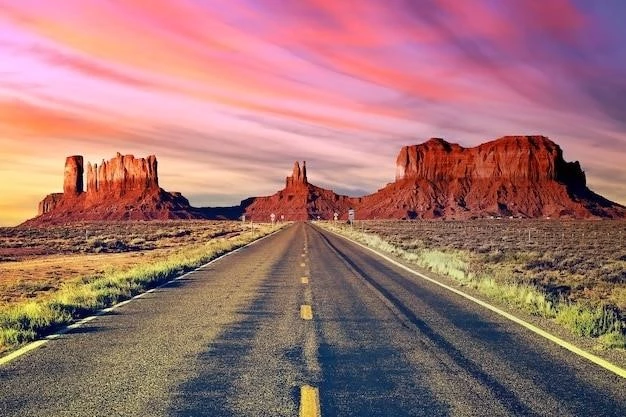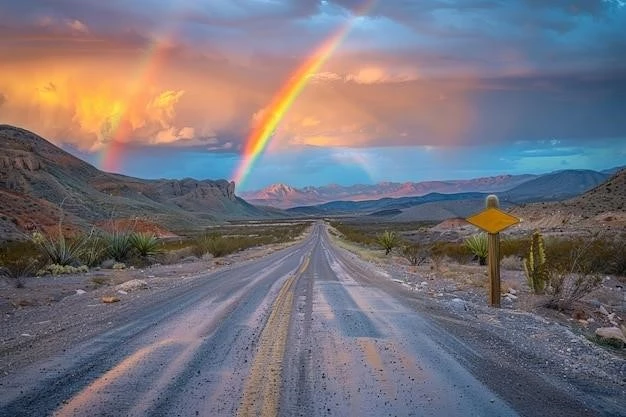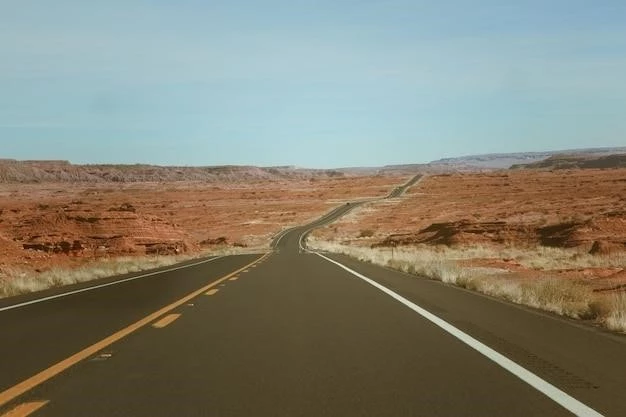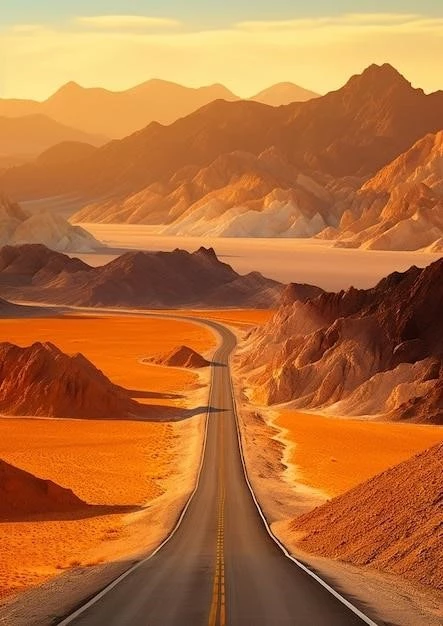Planning Your Adventure
Embarking on a road trip through the American Southwest is a thrilling endeavor, promising awe-inspiring landscapes and unforgettable experiences. To make the most of your 2024 adventure٫ meticulous planning is essential. Begin by deciding on the duration of your trip٫ considering whether you desire a quick 5-day escape or a more immersive two-week journey. This will influence your choice of destinations and the pace of your exploration.
Essential Information and Tips
A road trip through the American Southwest in 2024 requires careful preparation to ensure a smooth and enjoyable journey. Here are essential tips for a successful adventure:
Vehicle Choice and Preparation:
Given the vast distances and often rugged terrain, a reliable vehicle with good gas mileage is crucial. Consider an SUV or a spacious sedan with ample trunk space for luggage and supplies. Before embarking on your journey, ensure your vehicle is in optimal condition by scheduling a comprehensive check-up. Pay close attention to tire pressure, fluid levels, and brakes.
Navigation and Connectivity:
While cell phone service can be unreliable in remote areas, equip yourself with offline maps, GPS devices, or navigation apps. Familiarize yourself with the route beforehand and download maps for offline access. Consider a mobile Wi-Fi hotspot for consistent internet connectivity, allowing you to share your experiences and access real-time information.
Packing Essentials:
Pack light, but strategically. Essential items include comfortable clothing suitable for varying weather conditions, sturdy hiking shoes, sunscreen, a hat, sunglasses, and a reusable water bottle. Consider packing a first-aid kit, a flashlight, a basic tool kit, and a cooler for snacks and beverages.
Weather Considerations:
The Southwest is known for its arid climate and extreme temperatures. Be prepared for hot days and cool nights, especially during spring and fall. Pack layers of clothing to adjust to temperature fluctuations. Stay hydrated by drinking plenty of water throughout your trip.
Respect for Nature and Local Cultures:
When exploring the breathtaking natural wonders of the Southwest, prioritize responsible tourism. Stay on designated trails, pack out all trash, and be mindful of wildlife. Respect the cultural heritage of indigenous communities by observing local customs and supporting local businesses.
Permits and Reservations:
Some national parks and attractions may require permits or timed-entry reservations, especially during peak seasons. Research and secure these in advance to avoid disappointment. Accommodation options along popular routes can book up quickly, so reserve your lodging well ahead of time, especially if traveling during peak season.

Choosing the Right Time to Go
The American Southwest presents a unique set of seasonal considerations, each offering a distinct experience for road trippers. Selecting the optimal time for your 2024 adventure depends on your priorities and preferences:
Spring (March-May):
Spring paints the desert landscape with vibrant wildflowers, creating a photographer’s paradise. Temperatures are pleasant, ranging from mild to warm, making it ideal for hiking and outdoor activities. However, this is also the busiest season, so expect larger crowds and book accommodations well in advance.
Summer (June-August):
Summer brings scorching temperatures to the Southwest, often exceeding 100°F (38°C). While this may be appealing for those seeking intense desert heat, it’s crucial to take precautions against heatstroke and dehydration. Consider starting your days early to avoid the most intense midday sun. Summer offers fewer crowds and potentially lower accommodation prices.
Fall (September-November):
Fall offers a delightful balance of pleasant weather and fewer crowds. The summer heat subsides, making it more comfortable for hiking and outdoor exploration. The changing colors of foliage in higher elevations add a touch of autumnal beauty to the landscape.
Winter (December-February):
Winter in the Southwest brings cooler temperatures and occasional snowfall, particularly in higher elevations. While some hiking trails may be inaccessible, this season offers a unique perspective of the desert landscape. You’ll encounter fewer crowds and potentially lower accommodation rates. However, be prepared for occasional road closures due to snow or ice.
Ultimately, the best time to embark on your American Southwest road trip in 2024 depends on your personal preferences and tolerance for crowds and varying weather conditions. Research and consider the advantages of each season to make an informed decision that aligns with your travel style and desired experiences.
Top Destinations and Routes
The American Southwest offers a diverse tapestry of natural wonders, each deserving of a place on your 2024 road trip itinerary. Here are some top destinations and suggested routes to inspire your adventure:
The Grand Circle:
This iconic route encompasses a loop through Arizona, Utah, and Nevada, showcasing some of the region’s most renowned national parks. Begin in Las Vegas, Nevada, and make your way to Zion National Park in Utah, known for its towering sandstone cliffs and emerald pools. Continue to Bryce Canyon National Park, where hoodoos—spire-shaped rock formations—create a surreal landscape. Next, marvel at the grandeur of the Grand Canyon National Park in Arizona, an awe-inspiring testament to the power of erosion. Finally, loop back to Las Vegas through the Mojave Desert.
Route 66:
Experience a nostalgic journey along historic Route 66, traversing Arizona, New Mexico, and portions of Texas. Begin in Oklahoma City, Oklahoma, and immerse yourself in the retro Americana of this legendary highway. Visit quirky roadside attractions, savor classic diner fare, and soak up the history of this iconic route. End your journey in Santa Monica, California, where Route 66 concludes its journey at the Pacific Ocean.
Southwest Colorado Loop:
Explore the rugged beauty of Southwest Colorado, home to towering mountains, ancient ruins, and charming towns. Begin in Durango, Colorado, and ride the Durango & Silverton Narrow Gauge Railroad through the San Juan Mountains. Visit Mesa Verde National Park, home to well-preserved Ancestral Puebloan cliff dwellings. Continue to Telluride, Colorado, a charming mountain town known for its stunning scenery and outdoor recreation opportunities. Conclude your loop back in Durango, where you can enjoy the town’s vibrant arts and culture scene.
Las Vegas and the Neon Lights
While often considered a standalone destination, Las Vegas serves as a vibrant gateway to the natural wonders of the American Southwest. Before embarking on your 2024 road trip٫ consider spending a day or two experiencing the dazzling lights and entertainment of this iconic city.
A City of Contrasts:
Las Vegas is a city of contrasts, where the desert landscape meets towering resorts and the constant buzz of activity juxtaposes with the tranquility of nearby natural escapes. Stroll along the famed Las Vegas Strip, marveling at the architectural marvels and immersive themed resorts. Take in a world-renowned show, from Cirque du Soleil performances to headline musical acts. Indulge in a culinary adventure, with dining options ranging from celebrity chef restaurants to casual eateries serving up all-American classics.
Beyond the Strip:
Venture beyond the Strip to discover a different side of Las Vegas. Explore the Neon Museum, a captivating collection of vintage neon signs that illuminate the city’s history. Discover the vibrant arts district, home to galleries, studios, and murals that showcase the city’s creative spirit. For a change of pace, visit the Springs Preserve, a botanical garden and museum that celebrates the natural history of the Mojave Desert.
A Convenient Starting Point:
Las Vegas’s central location and accessibility make it an ideal starting point for your American Southwest road trip. Rent a car at McCarran International Airport and stock up on supplies before heading out to explore the region’s natural wonders. After a day or two of experiencing the city’s unique energy, you’ll be ready to embark on your desert adventure;
Whether you’re drawn to the glitz and glamour of the Strip or the city’s hidden gems, Las Vegas offers a unique blend of entertainment, culture, and urban excitement. Consider adding a day or two to your 2024 road trip itinerary to experience the captivating allure of this desert metropolis.
The Grand Canyon: A Natural Wonder
No road trip through the American Southwest is complete without witnessing the awe-inspiring grandeur of the Grand Canyon. This UNESCO World Heritage Site is a testament to the immense power of nature, showcasing millions of years of geological history.
A View from the Rim:
The Grand Canyon’s vast scale is best appreciated from its rim. Several viewpoints along the South Rim, easily accessible by car or shuttle bus, offer breathtaking panoramic vistas. Mather Point and Yavapai Point are particularly popular for their iconic views. For a more secluded experience, venture to the less-visited North Rim, which offers a different perspective of the canyon’s immensity.
Descending into the Depths:
For those seeking a more immersive experience, hiking trails descend from the rim to the canyon floor. The Bright Angel Trail and South Kaibab Trail are popular options, but be prepared for strenuous hikes and extreme temperatures. Permits are required for overnight trips and backcountry camping.
Alternative Perspectives:
Consider a helicopter or airplane tour for an unforgettable aerial perspective of the Grand Canyon’s vastness. Rafting trips on the Colorado River offer a unique way to experience the canyon from below, navigating its rapids and camping along its banks. For a scenic drive, explore the Desert View Drive along the South Rim, stopping at viewpoints and historic watchtowers.
The Grand Canyon is a popular destination, so plan your visit in advance, especially during peak seasons. Entrance fees apply, and accommodations within the park book up quickly. Pack plenty of water, sunscreen, and appropriate clothing for varying weather conditions.
A visit to the Grand Canyon is an experience that will stay with you long after you’ve left. Its sheer scale and raw beauty serve as a reminder of the profound power and artistry of the natural world.
Zion National Park: Majestic Canyons
Zion National Park, a sanctuary of towering sandstone cliffs and emerald pools, beckons adventurers to explore its majestic canyons and immerse themselves in its raw beauty. A must-see destination on your 2024 American Southwest road trip, Zion offers a diverse range of experiences for every type of traveler.
Exploring Zion Canyon:
The heart of Zion is Zion Canyon, a deep gorge carved by the Virgin River. A scenic drive along Zion Canyon Scenic Drive offers breathtaking views of towering cliffs and cascading waterfalls. However, during peak seasons, access to this road is restricted to shuttle buses, providing a more sustainable way to experience the park’s beauty.
Hiking Among Giants:
Zion is renowned for its hiking trails, ranging from easy strolls to challenging climbs. The iconic Angels Landing Trail, though strenuous, rewards hikers with unparalleled panoramic views from atop a narrow fin of rock. For a more moderate option, explore the Emerald Pools Trails, which lead to a series of cascading waterfalls and lush vegetation. The Narrows, a slot canyon hike through the Virgin River, offers a unique and unforgettable adventure.
Beyond the Canyon:
While Zion Canyon is the park’s centerpiece, don’t miss the opportunity to explore its lesser-known areas. Kolob Canyons, located in the park’s northwest corner, offers secluded trails and stunning views. The Pa’rus Trail, a paved path along the Virgin River, is perfect for biking or leisurely walks.
Zion is a popular park, so reservations are highly recommended, especially for accommodations and shuttle tickets. Entrance fees apply, and it’s advisable to arrive early in the day, particularly during peak seasons, to secure parking and make the most of your visit.
Zion National Park is a testament to the awe-inspiring power of nature, where towering cliffs meet emerald pools and adventure awaits around every bend. A visit to this natural wonder will leave you with memories to last a lifetime.

Bryce Canyon: Hoodoos and Hiking Trails
Bryce Canyon National Park, a natural amphitheater of crimson-colored hoodoos, is a sight to behold. These spire-shaped rock formations, sculpted by erosion over millions of years, create a surreal and otherworldly landscape that will leave you breathless.
A Symphony of Hoodoos:
The best way to experience Bryce Canyon’s unique beauty is from its rim. Scenic overlooks along the park’s main road offer breathtaking panoramic views of the hoodoo amphitheaters. Sunrise and sunset are particularly magical times to visit, as the changing light paints the hoodoos in a kaleidoscope of colors.
Descending into the Hoodoos:
For a more immersive experience, venture below the rim on one of Bryce Canyon’s many hiking trails. The Navajo Loop Trail and Queen’s Garden Trail form a popular loop that descends into the heart of the hoodoo formations. The Peek-a-Boo Loop Trail, known for its challenging switchbacks, rewards hikers with stunning views from atop the rim.
Stargazing Under Dark Skies:
Bryce Canyon is renowned for its exceptionally dark night skies, making it an ideal destination for stargazing. The park’s elevation and lack of light pollution offer unparalleled views of the Milky Way and constellations. Ranger-led astronomy programs are available during the summer months.
Bryce Canyon is smaller and more compact than its neighbor, Zion National Park, but it’s still advisable to plan your visit in advance. Entrance fees apply, and accommodations within the park book up quickly, especially during peak seasons. Be prepared for cooler temperatures at Bryce Canyon’s higher elevation, even during the summer months.
Bryce Canyon National Park is a testament to the artistry of nature, where hoodoos stand as silent sentinels to the passage of time. A visit to this natural wonder will leave you with a profound sense of awe and wonder.

Monument Valley: Iconic Desert Landscapes
Monument Valley, straddling the border of Arizona and Utah, is an iconic symbol of the American Southwest. Its towering sandstone buttes, sculpted by erosion over millions of years, have graced countless films, photographs, and postcards, becoming synonymous with the rugged beauty of the desert.
A Scenic Drive Through Time:
The best way to experience Monument Valley’s grandeur is on a scenic drive along the 17-mile Valley Drive. This unpaved road winds its way through the heart of the valley, offering breathtaking views of the iconic buttes from every angle. Be sure to stop at the numerous overlooks along the way to capture the perfect photograph.
Guided Tours and Cultural Experiences:
For a deeper understanding of the area’s cultural and geological significance, consider taking a guided tour. Navajo guides offer tours that provide insights into the history, traditions, and spiritual beliefs of the Navajo Nation, who have called this land home for centuries.
Hiking and Backpacking:
While most visitors experience Monument Valley from the comfort of their vehicles, hiking and backpacking opportunities are available for those seeking a more immersive adventure. Permits are required for overnight trips, and it’s essential to be prepared for the desert’s extreme temperatures and limited water sources.
Stargazing Under a Blanket of Stars:
Monument Valley’s remote location and lack of light pollution make it an ideal destination for stargazing. The night sky comes alive with a dazzling display of stars, planets, and constellations. Consider camping overnight to fully appreciate the celestial show.
Monument Valley is a place where time seems to stand still, where the forces of nature have sculpted a landscape of unparalleled beauty and grandeur. A visit to this iconic destination is an experience that will stay with you long after you’ve left the desert behind.
Arches National Park: Arches and Rock Formations
Arches National Park, home to the world’s largest concentration of natural sandstone arches, is a testament to the patient artistry of erosion. Over 2٫000 documented arches٫ sculpted by wind and water over millions of years٫ grace this otherworldly landscape٫ inviting exploration and wonder.
The park’s scenic drive winds its way through a mesmerizing landscape of towering sandstone fins, balanced rocks, and, of course, arches of all shapes and sizes. Stop at the numerous overlooks along the way to admire the views and capture photographs of these geological marvels;
Iconic Arches and Trails:
Delicate Arch, perhaps the park’s most iconic landmark, is a must-see. A short but moderately strenuous hike leads to a viewpoint overlooking this freestanding arch, particularly stunning at sunset. Landscape Arch, one of the world’s longest natural arches, is a testament to the delicate balance of erosion. Double Arch, as its name suggests, features two arches sharing a common base, offering a unique photographic opportunity.
Beyond the Arches:
While arches are the park’s namesake, don’t overlook the other fascinating rock formations. Balanced Rock, a massive boulder perched precariously on a slender pedestal, defies gravity. The Fiery Furnace, a maze of narrow canyons, offers a challenging but rewarding hike for experienced adventurers.
Arches National Park is a popular destination, so reservations are highly recommended, especially during peak seasons. Timed-entry tickets are required for entry from April through October. Be prepared for hot and dry conditions, and bring plenty of water, sunscreen, and a hat.
A visit to Arches National Park is a journey through time, where you’ll witness the awe-inspiring power of nature to sculpt a landscape of unparalleled beauty and wonder.
Canyonlands National Park: Island in the Sky
Canyonlands National Park, a vast and rugged wilderness carved by the Colorado River and its tributaries, is a testament to the raw power of erosion. The park is divided into three distinct districts: Island in the Sky, The Needles, and The Maze. Island in the Sky, the most accessible of the three, offers breathtaking panoramic views and a glimpse into the park’s immense scale.
A Mesa Above a Labyrinth of Canyons:
Island in the Sky is a mesa that rises over 1,000 feet above the surrounding canyons, offering unparalleled views of the park’s vastness. A scenic drive along the paved scenic road provides access to numerous overlooks, each revealing a different perspective of the canyon system below.
Hiking to the Edge:
For those seeking a closer look, numerous hiking trails wind their way from the mesa’s edge down into the canyons below. Mesa Arch Trail, a short and easy hike, leads to a natural sandstone arch perched on the edge of a cliff, framing a stunning view of the canyons beyond. Grand View Point Trail, a longer and more challenging hike, offers panoramic vistas of the entire Island in the Sky district.
Exploring by Four-Wheel Drive:
For the adventurous, four-wheel drive roads provide access to remote areas of Island in the Sky, offering a glimpse into the park’s backcountry. White Rim Road, a challenging and scenic 100-mile loop٫ requires a high-clearance vehicle and permits are required.
Island in the Sky is open year-round, but the best time to visit is during the spring and fall when temperatures are mild. Entrance fees apply, and it’s advisable to bring plenty of water, sunscreen, and a hat, as shade is limited.
Canyonlands National Park is a true wilderness experience, where solitude and silence reign supreme. A visit to Island in the Sky offers a glimpse into the heart of this rugged and awe-inspiring landscape.

Mesa Verde: Ancient Cliff Dwellings
Mesa Verde National Park, a UNESCO World Heritage Site, offers a captivating glimpse into the lives of the Ancestral Pueblo people who called this rugged landscape home for over 700 years. The park preserves some of the most remarkable archaeological sites in the United States٫ including intricate cliff dwellings built into the alcoves of towering sandstone cliffs.
A Legacy in Stone and Mortar:
Mesa Verde is home to over 5,000 known archaeological sites, including over 600 cliff dwellings. These structures, built between the 6th and 13th centuries, showcase the ingenuity and architectural prowess of the Ancestral Pueblo people. Cliff Palace, the park’s largest cliff dwelling, is a testament to their skill, with over 150 rooms and 23 kivas (ceremonial structures).
Exploring the Cliff Dwellings:
Access to the cliff dwellings is typically restricted to ranger-guided tours, which provide insights into the history, culture, and daily lives of the Ancestral Pueblo people. Popular tours include Cliff Palace, Balcony House, and Long House. Be aware that some tours involve climbing ladders and navigating narrow passages.
Beyond the Cliff Dwellings:
While the cliff dwellings are the park’s main attraction, Mesa Verde also offers opportunities for hiking, camping, and exploring the mesa top. The Chapin Mesa Archaeological Museum provides exhibits and artifacts that further illuminate the Ancestral Pueblo culture.
Planning Your Visit:
Mesa Verde is open year-round, but some sites and tours may have limited availability during the winter months. It’s advisable to purchase tour tickets in advance, especially during peak seasons. The park’s elevation and arid climate mean that temperatures can vary significantly, so be prepared for all types of weather.
A visit to Mesa Verde National Park is a journey through time, offering a profound connection to the past and a glimpse into the resilience and ingenuity of the Ancestral Pueblo people.

Route 66: Historic Road Trip Experience
Route 66, also known as the “Mother Road” or the “Main Street of America,” evokes a sense of nostalgia and adventure. While no longer a continuous highway, much of this iconic route, particularly in the American Southwest, remains drivable, offering a glimpse into a bygone era of roadside attractions, classic diners, and the romance of the open road.
A Journey Through Time:
Embark on a journey through time as you traverse stretches of Route 66, passing through small towns, historic trading posts, and remnants of the route’s heyday. Look for vintage neon signs, classic motels, and roadside diners that harken back to the golden age of road trips.
Highlights of Route 66 in the Southwest:
Begin your Route 66 adventure in Oklahoma City, Oklahoma, and follow the route westward. In Texas, stop at the Cadillac Ranch, an art installation featuring ten Cadillacs half-buried nose-down in the ground. In New Mexico, visit the Blue Hole, a crystal-clear swimming hole fed by an artesian spring. In Arizona, marvel at the Painted Desert and the Petrified Forest National Park, where ancient trees have been transformed into colorful stone;
Capturing the Spirit of the Road:
Route 66 is more than just a road; it’s a symbol of Americana, a testament to the spirit of adventure and the allure of the open road. Take your time, savor the journey, and embrace the quirky roadside attractions that make this route so unique.
Planning Your Route 66 Adventure:
While sections of Route 66 have been bypassed or abandoned, numerous resources are available to help plan your trip, including maps, guidebooks, and websites dedicated to preserving the history of this iconic highway.
A road trip along Route 66 is a journey through time, a chance to experience the nostalgia and adventure of the open road, and to discover the hidden gems and forgotten stories that lie along this iconic highway.










